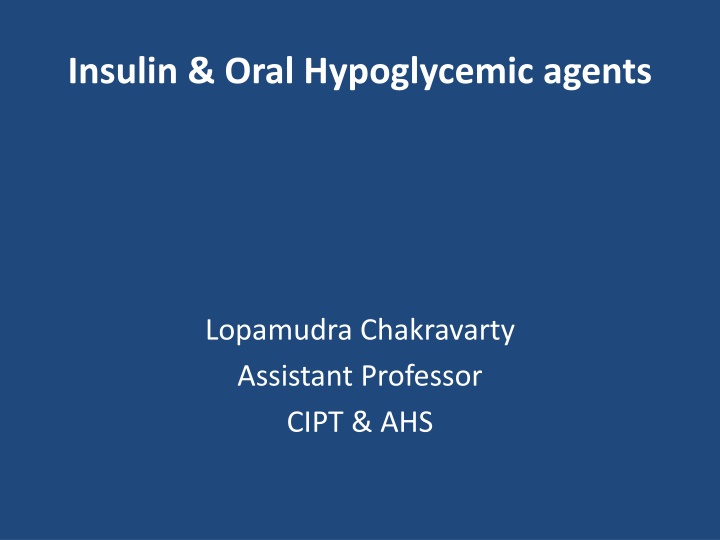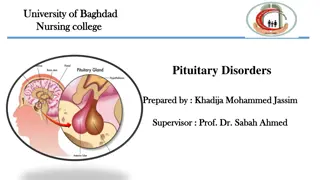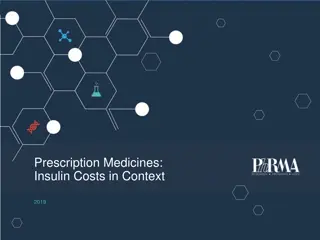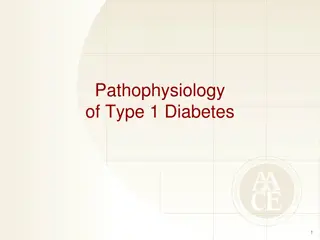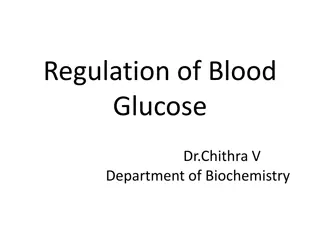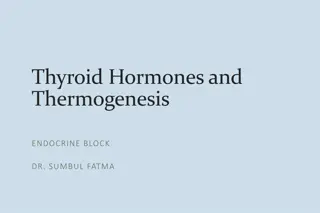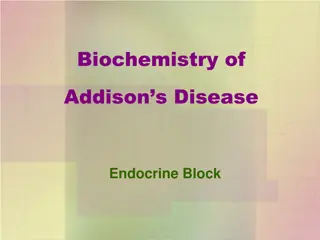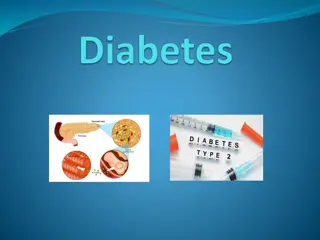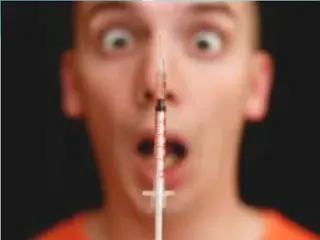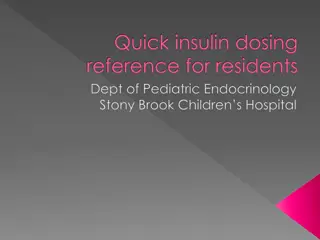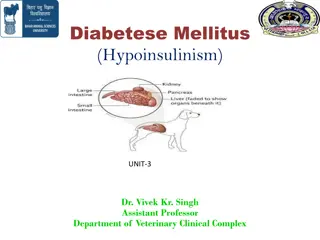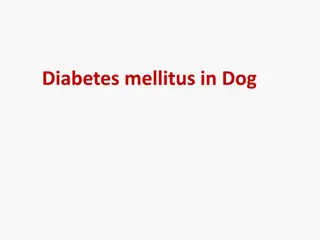Insulin: Hormone Synthesis & Regulation
Insulin, a vital hormone produced by the pancreas, plays a key role in regulating blood glucose levels through its synthesis process and controlled release in response to varying glucose concentrations. Learn about the physiological functions and importance of insulin in carbohydrate metabolism. Explore the intricate mechanism of insulin regulation and its essential role in maintaining metabolic balance.
Download Presentation

Please find below an Image/Link to download the presentation.
The content on the website is provided AS IS for your information and personal use only. It may not be sold, licensed, or shared on other websites without obtaining consent from the author.If you encounter any issues during the download, it is possible that the publisher has removed the file from their server.
You are allowed to download the files provided on this website for personal or commercial use, subject to the condition that they are used lawfully. All files are the property of their respective owners.
The content on the website is provided AS IS for your information and personal use only. It may not be sold, licensed, or shared on other websites without obtaining consent from the author.
E N D
Presentation Transcript
Insulin & Oral Hypoglycemic agents Lopamudra Chakravarty Assistant Professor CIPT & AHS
What is insulin? Insulin is a hormone made by an organ located behind the stomach called the pancreas. There are specialised areas within the pancreas called islets of Langerhans (the term insulin comes from the Latin insula that means island). The islets of Langerhans are made up of different type of cells that make hormones, the commonest ones are the beta cells, which produce insulin. It is a ploypeptide consisting 51 amino acids. A chain contain 21 and B chain 30 amino acids
Synthesis of Insulin It is very difficult for small proteins to fold into stable structures, so to avoid this problem larger precursors of insulin are synthesized first . Preproinsulin, the first precursor, is generated as a single chain when the insulin mRNA is translated. Once introduced into the the endoplasmic reticulum, the signal peptide is deleted, creating proinsulin . Proinsulin differs from insulin in that it has a third peptide, C, which connects the A and B peptides together. This C peptide, however, is spliced from the chain by several endopeptidases found in the endoplasmic reticulum, creating the active form of insulin. In the Golgi, the insulin (along with the lone C peptide) is enclosed within secretory granules, folded into its native structure and then the disulfide bonds are created to secure it in this conformation . The secretory granules then gather in the cytoplasm. The insulin remains here until the beta cells are stimulated, at which point exocytosis occurs and the insulin disperses into the pancreatic capillaries. Although it has no known biological function, the C peptide is also released into the blood stream as well.
Insulin Regulation When blood glucose tends to increase, such as is the case in the postprandial phase, insulin is released from pancreatic - cells, whereas in the fasting state, when glucose levels tend to be low, glucagon is released from pancreatic -cells. Both islet hormones try to normalize blood glucose levels. Insulin's action lowers blood glucose by stimulating glucose uptake by tissues, utilization and storage of glucose as glycogen in the liver and muscle. The opposing actions of glucagon aim to increase plasma glucose by stimulating glycogen breakdown into glucose and release into the bloodstream.
Physiological functions Carbohydrate Metabolism During digestion in the small intestine, glucose is released from carbohydrates (ie: sucrose or starch) and then diffuses into the blood stream. With the increase of glucose in the blood, insulin is secreted from the beta cells and helps cells throughout the body accept, utilize and store glucose. Muscle, Adipose, and Other Tissues These tissue types require the use of glucose transporters (a common type is GLUT4), which is only made available in the presence of insulin. The glucose transporters are found in cytoplasmic vesicles underneath the plasma membrane. However, once insulin binds to the receptors, these vesicles fuse with the plasma membrane and the glucose transporters penetrate through the plasma membrane. At this point, glucose can be transported into the cell at a rapid rate. Once blood levels return to normal conditions, insulin leaves the receptors, and the glucose transporters are moved back into the cytoplasm. Liver Tissue When glucose is released from carbohydrates in the small intestines a substantial portion goes directly to the cells of the liver, so that it can be changed from glucose to glycogen. The conversion of glucose to glycogen are activated by insulin . In terms of hepatic glucose homeostasis, there is an increase in the amount of sugar absorbed by the liver (glucose storage in form of glycogen) and a decrease in the amount of sugar released from the liver. Therefore, the overall effect is a decrease in blood sugar.
Cont. Lipid Metabolism In general, insulin not only encourages the use of carbohydrates over fatty acids for energy, but it also indirectly results in the accumulation of fat in the adipose tissue. Because the metabolism of lipids and carbohydrates are interrelated, insulin also has an effect on lipid metabolism. Liver Tissue If glycogen starts to build up to high levels in the liver (approximately 5% of the liver mass), the liver will repress additional synthesis. So when more glucose continues to enter the liver cells, it is redirected into a different metabolic pathway. Within this pathway, fatty acids are made and then transported out of the liver as lipoproteins. While circulating these lipoproteins are broken apart into free-floating fatty acids that are utilized in other tissues. Of these tissues, adipocytes, in particular, use the fatty acids in order to make triglycerides
Cont. Adipose Tissue Insulin prohibits lipase from functioning, so the triglycerides cannot be hydrolyzed into fatty acids. In this way insulin prevents the breakdown of fat in adipose tissue. In addition, when insulin is present, glucose can enter into the adipocytes, where it is then used to make glycerol. This glycerol along with fatty acids, which are transported from the liver, triglycerides are synthesized, allowing for further build up of fat in the tissue . In short, it triggers lipogenesis and inhibits lipolysis. Additional Functions of Insulin In addition to its role in carbohydrate and lipid metabolism, insulin serves the following functions : Increases amino acid transport into cells- when insulin levels are low, proteins are degraded Regulates transcription, changing the amount mRNA present in the cell Activates cell growth, DNA synthesis and cell replication Increases the permeability of most cells to potassium, magnesium and phosphate ions
What happens if too much insulin? This leads to abnormally low blood glucose levels (called hypoglycaemia). The body reacts to hypoglycaemia by releasing stored glucose from the liver in an attempt to bring the levels back to normal. Low glucose levels in the blood can make a person feel ill. The body mounts an initial 'fight back' response to hypoglycaemia through a specialised set of of nerves called the sympathetic nervous system. This causes palpitations, sweating, hunger, anxiety, tremor and pale complexion that usually warn the person about the low blood glucose level so this can be treated. However, if the initial blood glucose level is too low or if it is not treated promptly and continues to drop, the brain will be affected too because it depends almost entirely on glucose as a source of energy to function properly. This can cause dizziness, confusion, fits and even coma in severe cases.
What happens if too little insulin? People with type 1 diabetes produce very little or no insulin at all. This condition is caused when the beta cells that make insulin have been destroyed by antibodies , hence they are unable to produce insulin. With too little insulin, the body can no longer move glucose from the blood into the cells, causing high blood glucose levels. Type 2 diabetes can be caused by two main factors and its severity will depend on how advanced it is. Firstly, the patient s beta cells may have problems manufacturing insulin, so although some insulin is produced, it is not enough for the body s needs. Secondly, the available insulin doesn t work properly because the areas in the cell where insulin acts, called insulin receptors, become insensitive and stop responding to the insulin in the bloodstream.
Oral Hypoglycemic agents Oral Hypoglycemic agents lower glucose levels in the blood. They are commonly used in the treatment of diabetes mellitus The net effect is increased responsiveness of -cells to glucose ,resulting in more insulin being released at all blood glucose concentrations
Drug class Agents 1. Biguanides Metformin 2. Sulfonylureas First generation Second generation Tolazamide, Tolbutamide Glipizide,Glibenclamide,Glimipride Glicazide 3. Meglitinides Repaglimide, Nateglimide 4. Thiazolidinediones Rosiglitazone, Pioglitazone 5. -Glucosidase inhibitors Acarbose, Miglitol 6. DPP-4 inhibitors Sitagliptin, Vildagliptin, Saxagliptin,Linagliptin 7. Cycloset Bromocriptin
MOA Metformin increases hepatic adenosine monophosphate-activated protein kinase activity, thus reducing hepatic gluconeogenesis and lipogenesis, as well as increasing insulin-mediated uptake of glucose in muscles. Metformin is the initial drug-of-choice in patients with type 2 diabetes mellitus. It is given orally in 500 to 1000 mg tablets twice a day. ADR: Metformin: Gastrointestinal upset such as diarrhea (12% to 53%), nausea and vomiting (7% to 26%), flatulence (4% to 12%), chest discomfort, flushing, palpitation, headache (5% to 6%), chills, dizziness, taste disorder, diaphoresis, nail disease, skin rash, vitamin B12 deficiency.
MOA Sulfonylureas bind to adenosine triphosphate-sensitive potassium channels (K-ATP channels) in the beta cells of the pancreas; this leads to the inhibition of those channels and alters the resting membrane potential of the cell, causing an influx of calcium and the stimulation of insulin secretion. Glipizide is a 2.5 mg to 10 mg tablet, taken as a single dose or in two divided doses, 30 minutes before breakfast. Glimepiride is available as a 1 mg, 2 mg, or 4 mg tablets, taken once a day with breakfast or twice a day with meals. For patients at increased risk for hypoglycemia, such as older patients or those with chronic kidney disease, the initial dose could be as low as 0.5 mg daily. ADR: Sulfonylureas: Syncope (less than 3%), dizziness (2% to 7%), nervousness (4%), anxiety (less than 3%), depression (<3%), hypoesthesia (less than 3%), insomnia (<3%), pain (<3%), paresthesia (less than 3%), drowsiness (2%), headache (2%), diaphoresis (less than 3%), pruritus (1% to less than 3%), hypoglycemia (less than 3%), increased lactate dehydrogenase, diarrhea (1% to 5%), flatulence (3%), dyspepsia (less than 3%), and vomiting (less than 3%)
MOA Sulfonylureas bind to adenosine triphosphate-sensitive potassium channels (K-ATP channels) in the beta cells of the pancreas; this leads to the inhibition of those channels and alters the resting membrane potential of the cell, causing an influx of calcium and the stimulation of insulin secretion. Glipizide is a 2.5 mg to 10 mg tablet, taken as a single dose or in two divided doses, 30 minutes before breakfast. Glimepiride is available as a 1 mg, 2 mg, or 4 mg tablets, taken once a day with breakfast or twice a day with meals. For patients at increased risk for hypoglycemia, such as older patients or those with chronic kidney disease, the initial dose could be as low as 0.5 mg daily. ADR: Sulfonylureas: Syncope (less than 3%), dizziness (2% to 7%), nervousness (4%), anxiety (less than 3%), depression (<3%), hypoesthesia (less than 3%), insomnia (<3%), pain (<3%), paresthesia (less than 3%), drowsiness (2%), headache (2%), diaphoresis (less than 3%), pruritus (1% to less than 3%), hypoglycemia (less than 3%), increased lactate dehydrogenase, diarrhea (1% to 5%), flatulence (3%), dyspepsia (less than 3%), and vomiting (less than 3%)
MOA Meglitinides exerts its effects via different pancreatic beta-cell receptors, but they act similar to sulfonylureas by regulating adenosine triphosphate-sensitive potassium channels in pancreatic beta cells, thereby causing an increase in insulin secretion. Repaglinide is available as a 0.5 mg, 1 mg, or 2 mg tablets, taken orally in two to three divided doses per day. ADR: Repaglinide: Hypoglycemia (16% to 31%), weight gain, headache (9% to 11%), upper respiratory tract infection (10% to 16%), and cardiovascular ischemia (4%).
MOA Thiazolidinediones activate peroxisome proliferator-activated receptor gamma (PPAR- ), a nuclear receptor, to increase insulin sensitivity . Pioglitazone is given as 15 mg, 30 mg, or 45 mg tablets daily. Rosiglitazone, while rarely used, is given as 2 mg, 4 mg, or 8 mg daily ADR: Thiazolidinediones: Edema (less than or equal to 27%), hypoglycemia (less than or equal to 27%), cardiac failure (less than or equal to 8%), headache, bone fracture (less than or equal to 5%), myalgia (5%), sinusitis (6%), and pharyngitis.
MOA Alpha-glucosidase inhibitors competitively inhibit alpha-glucosidase enzymes in the intestinal brush border cells that digest the dietary starch, thus inhibiting the polysaccharide reabsorption as well as the metabolism of sucrose to glucose and fructose. Alpha-glucosidase inhibitors are available as 25 mg, 50 mg, or 100 mg tablets, given three times a day just before meals. ADR:Alpha-glucosidase inhibitors: Adverse effects include flatulence (74%) that tends to decrease with time, diarrhea (31%), abdominal pain (19%), and increased serum transaminases (less than or equal to 4%)
MOA DPP-4 inhibitors inhibit the enzyme dipeptidyl peptidase 4 (DPP- 4). These deactivate glucose-dependent insulinotropic polypeptide (GIP) and glucagon-like peptide 1 (GLP-1), among others. Therefore, these influence glucose control through multiple effects, such as decreasing glucagon release and increasing glucose- Among the DPP- 4 inhibitors, linagliptin is available as 5 mg daily. Vildagliptin is given as 50 mg once or twice weekly, Sitagliptin as 25 mg, 50 mg, or 100 mg once daily, and Saxagliptin as 2.5 mg or 5 mg once daily. ADR:Sitagliptin: Hypoglycemia (1%), nasopharyngitis (5%), increased serum creatinine, acute pancreatitis (including hemorrhagic or necrotizing forms), and acute renal failure. Saxagliptin: Peripheral edema (4%), headache (7%), hypoglycemia (6%), urinary tract infection (7%), lymphocytopenia (2%), and acute pancreatitis.
MOA Cycloset, (bromocriptine) a sympatholytic dopamine D2 receptor agonist, that reset the hypothalamic circadian rhythm, which might have been altered by obesity. This action results in the reversal of insulin resistance and a decrease in glucose production. Cycloset has an initial dose of 0.8 mg once daily, which is gradually increased to the usual dose of 1.6 mg to 4.8 mg once daily. Allergy to the drug, breastfeeding.
Thank you my dear students
